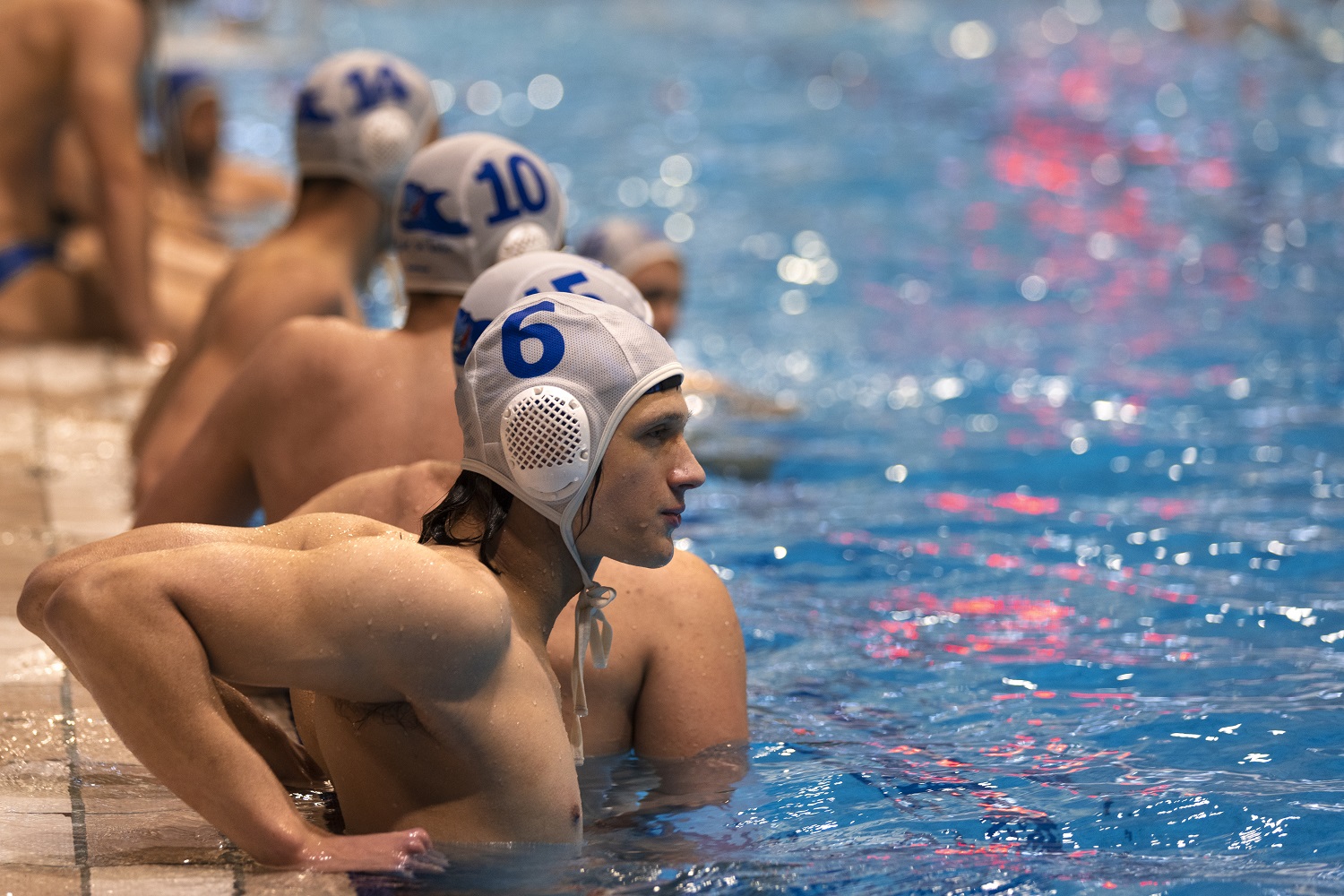Determinantes de Desempenho no Polo Aquático Juvenil
O Estudo INEX

Downloads
Palavras-chave:
polo aquático, antropometria, desempenho motor, desenvolvimentoResumo
Devido ao crescente envolvimento dos jovens na prática do pólo aquático, pretendemos caracterizar os jogadores agrupados por idade em termos antropométricos, habilidades motoras gerais e específicas e domínios contextuais. Também examinamos as associações das habilidades específicas dos jogadores com suas características antropométricas e motoras gerais. Cento e um jogadores masculinos de pólo aquático, agrupados em coortes de 12, 13 e 14 anos, foram recrutados. ANOVA one-way explicou a variância idade-coorte, e uma regressão linear múltipla foi usada para avaliar a associação entre as variáveis. A variação nas coortes foi explicada pela envergadura (25%), estatura, largura e comprimento da mão (17%), massa magra (18%), sprint de 20 m (16%), abdominais (18%), arremesso de medicine ball (27%), desempenho anaeróbico (31%) e aeróbico (21%), mudança de direção (18%) e salto vertical na água (14%). A variação do salto vertical na água, sprint de 10 m, mudança de direção e aptidão aeróbica para as características antropométricas dos jogadores foram, 32, 25, 14 e 10% (respectivamente). A força explosiva dos membros superiores dos jogadores explicou 30, 22 e 17% da variância para salto vertical na água, sprint de 10 m e aptidão aeróbica, respectivamente. A massa corporal teve uma associação inversa e a envergadura teve uma associação direta com o salto vertical na água e a capacidade de velocidade de natação, a envergadura teve uma associação inversa e direta com a mudança de direção e aptidão aeróbica, respectivamente. A força explosiva dos membros superiores relacionou-se diretamente com o salto vertical na água e habilidades de condicionamento aeróbico, mas inversamente com pontuações de sprint de 10 m.
Referências
(1) Vaeyens R, Malina RM, Janssens M, Van Renterghem B, Bourgois J, Vrijens J, et al. A multidisciplinary selection model for youth soccer: the Ghent Youth Soccer Project * Commentary. British Journal of Sports Medicine [Internet]. 2006 Sep 15 [cited 2019 Jun 3];40(11):928–34. Available from: https://www.ncbi.nlm.nih.gov/pmc/articles/PMC2465033/
(2) Falk B, Lidor R, Lander Y, Lang B. Talent identification and early development of elite water-polo players: a 2-year follow-up study. Journal of Sports Sciences. 2004 Apr;22(4):347–55.
(3) Martin MS, Pareja Blanco F, De Villarreal ES. Effects of Different In-Season Strength Training Methods on Strength Gains and Water Polo Performance. Int. J. Sports Physiol. Perform. 2021; 16, 591–600.
(4) Theodoros Platanou, Evdokia Varamenti. Relationships between anthropometric and physiological characteristics with throwing velocity and on water jump of female water polo players. PubMed. 2011 Jun 1;51(2):185–93.
(5) Koopmann T, Faber I, Baker J, Schorer J. Assessing Technical Skills in Talented Youth Athletes: A Systematic Review. Sports Med. 2020; 50, 1593–1611.
(6) NAKASHIMA M, MINAMI Y, TAKAGI H. Optimizing simulation for lower limb motion during throwing in water polo. Mechanical Engineering Journal. 2015;2(4):14-0047214-00472.
(7) Smith HK. Applied Physiology of Water Polo. Sports Medicine. 1998;26(5):317–34.
(8) G Melchiorri, Padua E, Sardella F, Manzi V, Tancredi V, Bonifazi M. Physiological profile of water polo players in different competitive levels. PubMed. 2010 Mar 1;50(1):19–24.
(9) Tan FH, Polglaze T, Dawson B, Cox G. Anthropometric and Fitness Characteristics of Elite Australian Female Water Polo Players. Journal of Strength and Conditioning Research. 2009 Aug;23(5):1530–6.
(10) Canossa S, Fernandes RJ, Estriga L, Abraldes JA, Lupo C, Garganta JM. Water Polo Offensive Methods after the 2018 FINA Rules Update. International Journal of Environmental Research and Public Health. 2022 Feb 23;19(5):2568.
(11) Kondric M, Uljevic O, Gabrilo G, Kontic D, Sekulic D. General Anthropometric and Specific Physical Fitness Profile of High-Level Junior Water Polo Players. Journal of Human Kinetics. 2012 Jan 1;32(1).
(12) Ferragut C, Abraldes J, Vila H, Rodríguez N, Argudo F, Fernandes R. Anthropometry and throwing velocity in elite water polo by specific playing positions. Journal of Human Kinetics. 2011 Mar 1;27(1):31–44.
(13) McCluskey, L.; Lynskey, S.; Leung, C.K.; Woodhouse, D.; Briffa, K.; Hopper, D. Throwing velocity and jump height in female water polo players: Performance predictors. J. Sci. Med. Sport 2010, 13, 236–240.
(14) Tan, F.; Polglaze, T.; Dawson, B. Throwing velocity and jump height in female water polo players: Performance predictors. Journal of Science and Medicine in Sport [Internet]. 2010 Mar 1 [cited 2021 Apr 12];13(2):236–40. Available from: https://www.sciencedirect.com/science/article/abs/pii/S144
(15) Alcaraz PE, Abraldes JA, Ferragut C, Vila H, Rodríguez N, Argudo FM. Relationship Between Characteristics of Water Polo Players and Efficacy Indices. The Journal of Strength & Conditioning Research [Internet]. 2012 Jul 1 [cited 2020 Mar 30];26(7):1852–7. Available from: https://journals.lww.com/nsca-jscr/fulltext/2012/07000/relationship_between_characteris
(16) Botonis PG, Toubekis AG, Platanou TI. Concurrent Strength and Interval Endurance Training in Elite Water Polo Players. Journal of Strength and Conditioning Research. 2016 Jan;30(1):126–33.
(17) Lupo C, Capranica L, Cugliari G, Miguel Ángel Gómez, Tessitore A. Tactical swimming activity and heart rate aspects of youth water polo game. PubMed. 2016 Sep 1;56(9):997–1006.
(18) Keiner M, Rähse H, Wirth K, Hartmann H, Fries K, Haff GG. Influence of Maximal Strength on In-Water and Dry-Land Performance in Young Water Polo Players. Journal of Strength and Conditioning Research [Internet]. 2020 Jul 1;34(7):1999–2005. Available from: https://pubmed.ncbi.nlm.nih.gov/29863590/
(19) Aleksandrovic M, Radovanovic D, Okicic T, Madic D, Georgiev G. Functional Abilities as a Predictor of Specific Motor Skills of Young Water Polo Players. Journal of Human Kinetics. 2011 Sep 1;29(1):123–32.
(20) Theodoros Platanou. On-water and dryland vertical jump in water polo players. PubMed. 2005 Mar 1;45(1):26–31.
(21) Canossa S, Abraldes JA, Estriga L, Fernandes RJ, Garganta J. Water Polo Shooting Performance: Differences Between World Championship Winning, Drawing and Losing Teams. Journal of Human Kinetics. 2020 Mar 31;72(1):203–14.
(22) Platanou T. Time-motion analysis of international level water polo players. J. Hum. Movement Stud. 2004; 46, 319–331.
(23) Botonis PG, Toubekis AG, Terzis GD, Geladas ND, Platanou TI. Performance Decrement and Skill Deterioration During a Water Polo Game are Linked With the Conditioning Level of the Athletes. Journal of Strength and Conditioning Research. 2016 Apr;30(4):1033–41.
(24) Kawai E, Tsunokawa T, Takagi H. Estimating the hydrodynamic forces during eggbeater kicking by pressure distribution analysis. Heliyon. 2018 Dec;4(12):e01095.
(25) De Jesus K, Figueiredo P, De Jesus K, Pereira F, Vilas-Boas JP, Machado L, et al. Kinematic analysis of three water polo front crawl styles. Journal of Sports Sciences. 2012 Apr;30(7):715–23.
(26) Vilas-Boas JP, Ramos RJ, Fernandes RJ, Silva AJ, Rouboa AI, Machado L, et al. Hydrodynamic Analysis of Different Finger Positions in Swimming: A Computational Fluid Dynamics Approach. Journal of Applied Biomechanics. 2015 Feb;31(1):48–55.
(27) Stenling A, Lindwall M, Hassmén P. Changes in perceived autonomy support, need satisfaction, motivation, and well-being in young elite athletes. Sport, Exercise, and Performance Psychology. 2015;4(1):50–61.
(28) Feltz DL, Chase MA, Moritz SE, Sullivan PJ. A conceptual model of coaching efficacy: Preliminary investigation and instrument development. Journal of Educational Psychology. 1999;91(4):765–76.
(29) Lemyre F, Trudel P, Durand-Bush N. How Youth-Sport Coaches Learn to Coach. The Sport Psychologist. 2007 Jun;21(2):191–209.
(30) Abós Á, Murillo M, Sevil-Serrano J, García-González L. How coaches’ need-supportive and controlling behaviors are related to different (mal)adaptive outcomes in water polo players: a person-centered approach. Current Psychology. 2021 Jul 30;
(31) Hellstedt JC. The Coach / Parent / Athlete Relationship. The Sport Psychologist. 1987 Jun;1(2):151–60.
(32) Dorsch TE, Smith AL, Wilson SR, McDonough MH. Parent goals and verbal sideline behavior in organized youth sport. Sport, Exercise, and Performance Psychology. 2015;4(1):19–35.
(33) Viero V, Triossi T, Bianchi D, Campagna A, Melchiorri G. Physical and performance variables for talent identification in water polo. The Journal of Sports Medicine and Physical Fitness. 2020 Nov;60(10).
(34) Guimarães E, Baxter-Jones ADG, Williams AM, Tavares F, Janeira MA, Maia J. The role of growth, maturation and sporting environment on the development of performance and technical and tactical skills in youth basketball players: The INEX study. J. Sports Sci. 2021; 39, 979–991.
(35) Kelly, J.; Metcalfe, J. Validity and Reliability of Body Composition Analysis Using the Tanita BC418-MA. J. Exerc. Physiol. 2012; 15, 74–83.
(36) MIRWALD RL, G. BAXTER-JONES AD, BAILEY DA, BEUNEN GP. An assessment of maturity from anthropometric measurements. Medicine & Science in Sports & Exercise. 2002 Apr;34(4):689–94.
(37) MacDougall JD, Wenger HA. Physiological Testing of the High-performance Athlete. Champaign, Ill. : Human Kinetics Books; 1991.
(38) Bangsbo J, Iaia FM, Krustrup P. The Yo-Yo intermittent recovery test: A useful tool for evaluation of physical performance in intermittent sports. Sports Med. 2008; 38, 37–51.
(39) Kirkendall, D.R.; Gruber, J.J.; Johnson, R.E. Measurement and Evaluation for Physical Educators. Human Kinetics; 1987.
(40) American Alliance For Health, Physical Education, Recreation, And Dance. Health related physical fitness : technical manual. Reston, Virg.: American Alliance For Health, Physical Education, Recreation And Dance; 1984.
(41) Rago V, Brito J, Figueiredo P, Carvalho T, Fernandes T, Fonseca P, et al. Countermovement Jump Analysis Using Different Portable Devices: Implications for Field Testing. Sports [Internet]. 2018 Aug 31 [cited 2020 Jan 7];6(3):91. Available from: https://www.ncbi.nlm.nih.gov/pmc/articles/PMC6162675
(42) Mayhew J, Ware J, Johns R, Bemben M. Changes in Upper Body Power Following Heavy-Resistance Strength Training in College Men. International Journal of Sports Medicine. 1997 Oct;18(07):516–20.
(43) Semenick D. TESTS AND MEASUREMENTS: The T-test. National Strength & Conditioning Association Journal. 1990;12(1):36.
(44) Rechichi C, Dawson B, Lawrence SR. A multistage shuttle swim test to assess aerobic fitness in competitive water polo players. Journal of Science and Medicine in Sport. 2000 Mar;3(1):55–64.
(45) Tucher G, de S. Castro FA, da Silva AJRM, Garrido ND. Sensitivity and validity of a functional test for agility performance in water polo players. Kinesiology. 2016;48(1):124–31.
(46) Canossa S, Abraldes JA, Soares MS, Fernandes JR, Garganta JM. Vertical jump and shot speed, efficacy and accuracy in water polo. International Journal of Performance Analysis in Sport. 2016 Apr;16(1):64–79.
(47) Argudo Iturriaga MF, Ruiz Lara E, Ignacio Alonso Roque J. Influence of the efficacy values in numerical equality on the condition of winner or loser in the 2003 Water Polo World Championship. International Journal of Performance Analysis in Sport. 2008 Feb;8(1):101–12.
(48) Chelladurai P, Saleh SD. Dimensions of Leader Behavior in Sports: Development of a Leadership Scale. Journal of Sport Psychology. 1980 Apr;2(1):34–45.
(49) LÓPEZ-PLAZA D, BORGES PJ, ALACID F, ARGUDO FM. Influence of maturity status on morphology, grip and throwing speed in young elite water polo players. The Journal of Sports Medicine and Physical Fitness. 2021 Oct;61(11).
(50) De Siati F, Laffaye G, Gatta G, Dello Iacono A, Ardigò LP, Padulo J. Neuromuscular and technical abilities related to age in water-polo players. Journal of Sports Sciences. 2015 Dec 8;34(15):1466–72.
(51) Dopsaj M, Mijalkovski Z, Vasilovski N, Copic N, Brzakovic M, Markovic M. Morphological Parameters and Handgrip Muscle Force Contractile Characteristics in the First Selection Level in Water Polo: Differences between U15 Water Polo Players and the Control Group. Hum. Sport Med. 2018; 18, 5–15.
(52) Royal KA, Farrow D, Mujika I, Halson SL, Pyne D, Abernethy B. The effects of fatigue on decision making and shooting skill performance in water polo players. Journal of Sports Sciences. 2006 Aug;24(8):807–15.
(53) Botonis PG, Toubekis AG, Platanou TI. Physiological and Tactical On-court Demands of Water Polo. Journal of Strength and Conditioning Research. 2019 Nov;33(11):3188–99.
(54) Lupo C, Tessitore A, Cortis C, Ammendolia A, Figura F, Capranica L. A physiological, time–motion, and technical comparison of youth water polo and Acquagoal. Journal of Sports Sciences. 2009 Jun;27(8):823–31.
(55) Wright T, Trudel P, Culver D. Learning how to coach: the different learning situations reported by youth ice hockey coaches. Physical Education & Sport Pedagogy. 2007 Jun;12(2):127–44.
OBS.:
Artigo adaptado e traduzido para o português pelos editores de NADAR! SWIMMING MAGAZINE para republicação, conforme normas de submissão do periódico. Versão original em: https://www.mdpi.com/1660-4601/19/9/4938 LICENÇA ORIGINAL E DA ADAPTAÇÃO: https://creativecommons.org/licenses/by/4.0/. MDPI stays neutral with regard to jurisdictional claims in published maps and institutional affiliations.
Publicado
Como Citar
Edição
Seção
ARK
Licença
Copyright (c) 2023 Francisco Noronha, Sofia Canossa, João P Vilas-Boas, José Afonso, Flávio Castro, Ricardo J Fernandes

Este trabalho está licenciado sob uma licença Creative Commons Attribution 4.0 International License.






